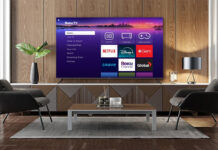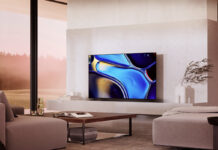 4K is so 2020. In 2022, it’s time we start looking into the future. For the next generation of televisions, many early adopters want the latest and greatest technology. 8K TVs is where it’s at. If you’re over 4K and ready to make the jump, you’ve come to the right place.
4K is so 2020. In 2022, it’s time we start looking into the future. For the next generation of televisions, many early adopters want the latest and greatest technology. 8K TVs is where it’s at. If you’re over 4K and ready to make the jump, you’ve come to the right place.
I’m reviewing the Samsung 65” Neo QLED 8K (QN800B) TV. This television has 33 million pixels and a resolution four times the resolution of 4K (7,680 x 4,320). 8K AI upscaling of 4K content uses 20 different neural networks to deliver near-8K picture quality. Is now the right time to make the switch to an 8K television? Let’s find out.
Samsung 65” Neo QLED 8K Specs
- Supports resolutions of up to 7,680 x 4,320
- 8K AI Upscaling of 4K content, enhances content to near 8K picture quality
- Wi-Fi 6, AirPlay 2, and Bluetooth BT4.2 connectivity
- Eco-friendly solar cell remote control
- Hands-free operation with Google Assistant, Amazon Alexa, or Bixby voice assistant
Design of the Samsung 65″ Neo QLED 8K
The Samsung Neo QLED 8K TV has three different sizes: 65”, 75”, 85”. I got the 65” version. The total dimensions are approximately 57”x 33” x 0.7” (WHD). It weighs about 51lbs without the stand and 69lbs with the stand.
The Neo QLED has a sleek, modern design fitting for an 8K television. The edges are perforated and act like vents for cooling. They also act as a speaker grill for the 70-watt Dolby Atmos channel speakers. There is a thin bezel around the screen but it’s hardly noticeable making for a bezel-less appearance.
Charging the SolarCell Remote
 Included with the TV is Samsung’s new SolarCell Remote which removes the need for disposable batteries. Over the course of seven years, Samsung estimates these new SolarCell remotes will avoid 99 million discarded batteries.
Included with the TV is Samsung’s new SolarCell Remote which removes the need for disposable batteries. Over the course of seven years, Samsung estimates these new SolarCell remotes will avoid 99 million discarded batteries.
To charge, I set the remote with the solar panel facing up. It can charge from outdoor and indoor light or via USB-C for a quick charge. To preserve its charge, Samsung added RF harvesting capabilities. The controller collects your home router’s radio waves and converts them to energy. That is freaking amazing.
Samsung One Connect on the Neo QLED 8K TV
Most Samsung TVs use the One Connect box and the Neo QLED 8K is no exception. Here you will find four HDMI 2.1 ports with eARC/ARC, three USB ports, a LAN port, digital audio out, etc. The back of the stand houses an area to store the One Connect box. It comes with a shorter connection cable for this approach. The longer cable is to set up the One Connect box in a different location, like an entertainment cabinet.
Display quality on the Samsung Neo QLED 8K TV
This was my first time reviewing an 8K television. I placed it on an entertainment cabinet in my living room directly facing a large window. The big challenge was getting legitimate 8K content for this review. While there is 8K YouTube, it’s actually streaming in 4K. Right now, it’s next to impossible to get genuine 8K content. Therefore, I’m assessing the performance based on the AI upscaling of 4K content to 8K.
I watched Animal Planet on Netflix which streams in 4K. The upscaled 4K did have a sharpened look. Without a side-by-side comparison to a 4K TV of the same footage, it’s hard to describe the difference. Was I really looking at 4K footage upscaled to near-8K picture quality? I don’t know. What I can say is that the footage looked amazing. I could see the tiny hairs on animals. I was fully immersed in what I was watching, I totally forgot I was doing a review.
Another thing I noticed about the Neo QLED 8K was the impressive viewing angles. It has an Anti-Reflective screen with wide viewing angles. As I moved around different seating angles, I didn’t see any differences on the screen. Colours were consistent from different angles, and the ambient light was nicely reflected away.
The quality of the picture looked great both day and night. The screen does a great job of minimizing glare. This is likely due to Samsung’s Anti Reflection technology. It minimizes reflecting light. Since I had it facing a large window, I still could see reflections on dark screens or white screens when the TV was on. When there were a lot of colours on screen, the reflections were minimized, but they were still there. If I looked for it, I could see it. But when I watched 4K content, I didn’t notice it at all. Basically, you have to look for glare and reflections to see it.
Samsung’s Smart Hub interface
This was my first time experiencing Samsung’s new Smart Hub interface. It starts to understand the content you like, and provides it front and center on the main interface. There are three categories for discovery: Media, Game, and Ambient. There’s a lot of free content inside Samsung’s Smart Hub. I could also download additional apps like Plex, MLB, and UFC. The preinstalled ones like YouTube and Netflix were enough for me.
Going through all the different types of content, I realize you don’t need a cable subscription to feel like you still have one. The solar remote control also has a dedicated button for Netflix, Samsung TV Plus, Disney+, and Prime Video. Samsung TV Plus looks and feels like cable television except it is getting free content like CBC News from the Internet. You can switch channels on the remote as if you were channel surfing on cable television. This is a great feature for people who want to cut the cord without feeling like they did.
Is now the time to get an 8K TV?
We’re currently in a weird place where we have 8K televisions, but no genuine 8K content. I remember when this happened when 4K TVs came out. History has a funny way of repeating itself. I’m not at all surprised that 8K TVs came out before 8K content. That’s just the way it is with advancements in TV screen technology.
So the big question is this—should you get an 8K TV now or wait? Personally, I think it comes down to price and budget. If you already watch a lot of 4K content, and an 8K TV like the Samsung Neo QLED goes on sale, get it. You will immediately see the difference in 4K content. Whatever the AI upscaling is doing, it’s working. I wish I could run a side-by-side experiment to prove this point.
Most people started to buy 4K TVs once Netflix supported 4K streaming. That was the big turning point. I think the same will happen with 8K TVs. Until we get easy access to 8K content, 8K TVs will be purchased by early adopters and/or dedicated gamers. They are the ones who will get the most out of an 8K television.
Final thoughts
It’s hard to believe that we already have 8K TVs to choose from. Just like 4K, the technology is coming faster than the content. This means consumers today can future-proof their TV buying decision with an 8K TV. However, I don’t think the average buyer is interested in an 8K TV in 2022. Most people will wait. Others, like gamers and early tech adopters, can’t wait to get an 8K TV. If that’s you, seeing is believing, 8K footage looks amazing. I speak from experience.
If you’re ready for an 8K TV, give the Samsung 65” Neo QLED 8K a good look. The picture quality is top-notch, the viewing angles are great, and the Smart Hub has endless free content. You will not be disappointed.









